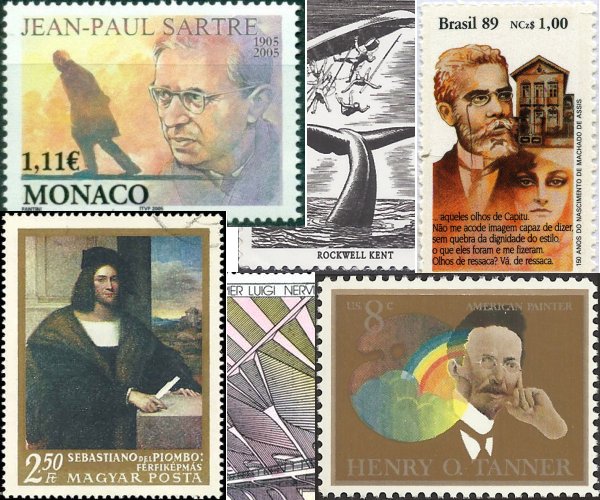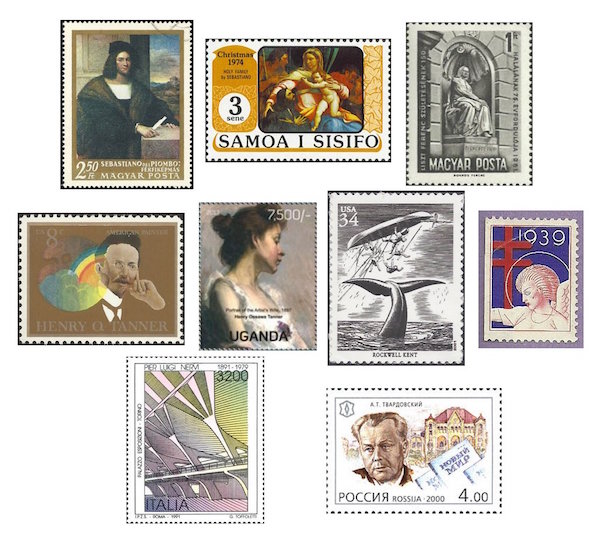The Arts on the Stamps of the World — June 21
An Arts Fuse regular feature: the arts on stamps of the world.

By Doug Briscoe
Mrs. Premise and Mrs. Conclusion are unable to agree on a nice point of philosophy, so they make a phone call. “Est-ce que Jean est chez vous? Non? Oh, merde.” “Jean” is one of our three A-listers on today’s Arts on the Stamps of the World. The other two are the great(est) Brazilian writer Machado de Assis and the American caricaturist Al Hirschfeld. As usual, we have many more artists to investigate as we look at their postal avatars.
I can distinctly remember as a young man approaching the Roads to Freedom trilogy by Jean-Paul Sartre (21 June 1905 – 15 April 1980) with some trepidation, expecting it to be well beyond my ability to grasp. In the event I found the books accessible enough, at least as narratives (I probably missed their subtler philosophical points). A few facts about Sartre. His mother was a cousin of Albert Schweitzer. His lifelong relationship with Simone de Beauvoir began as early as 1929 at the École Normale. He was for nine months a prisoner of war during World War II, a period that cannot have been excessively harsh, as he wrote his first drama there and read Heidegger, who would prove such a strong influence on his thinking. He declined both the Légion d’honneur and the 1964 Nobel Prize in Literature. When asked what he regarded as his most important works, he cited Nausea, No Exit, The Devil and the Good Lord, the essay “Saint Genet”, and the Critique of Dialectical Reason.
Brazilian novelist, playwright, and poet Joaquim Maria Machado de Assis (21 June 1839 – 29 September 1908) is in all likelihood the single greatest figure in Brazilian literature. Born in poverty to the son of slaves, 15-year-old Joaquim had a poem printed in a newspaper and the next year started work for another. Its editor gave him encouragement, and the writer José de Alencar introduced him to English. Machado’s quick mind absorbed the language and enabled him to to explore the classics of that literature. (He had already learned French and in later years would teach himself German and Greek.) The progressive Emperor Dom Pedro II, who frequently sponsored young talent, hired him to work with the official gazette and gave him a knighthood. There are many short stories, and at least five of Machado’s novels are considered masterpieces. One of them, the stylistically forward-looking short novel Memórias Póstumas de Brás Cubas (Posthumous Memoirs of Brás Cubas, also translated as Epitaph of a Small Winner), is one of Woody Allen’s favorite books.

Al Hirschfeld (June 21, 1903 – January 20, 2003) has no stamp of his own, but his unmistakable caricatures were twice used for sets of stamps remembering great American entertainers of the past: a 1991 strip of five comedians and a block of ten stars of the silent screen. (Since we have seen or will see most of these on the birthdays of their subjects, I show only reduced scale images of the complete sets today.) In his uncanny caricatures Hirschfeld almost always worked in black and white and with a crow’s quill rather than a pen. He also made many paintings and book illustrations in color. After the birth of his daughter he famously hid the name NINA in his works.
The Italian painter known to us as Sebastiano del Piombo was born Sebastiano Luciani in about 1485 and earned his nickname from serving as Keeper of the Seal to the Papacy—or, as the Italians called it, Keeper of the Lead (Piombatore)—a position he held from 1531. He had come from Venice, where he had been a lutenist before studying painting with Giovanni Bellini and Giorgione. Del Piombo was a friend of both Michelangelo and Ariosto. He died in this date in 1547. The Hungarian stamp shows us his Portrait of a Man (c1515), and the one from Samoa his Madonna and Child with Saints and a Donor (1517).
The Hungarian sculptor Alojs Stróbl (21 June 1856 – 13 December 1926) left memorials of many great figures in Hungarian arts and history. He first came to fame with his arresting Perseus of 1882, then went on to create a pair of statues of the composers Erkel and Liszt for the entrance of the Budapest Opera, whereupon he became Hungary’s sculptor of choice. I’ve known about the Liszt stamp for quite some time, but was not aware that the sculpture was by Stróbl until finding it on this nice philatelic post about sculpture on stamps.

Two American artists come next. Henry Ossawa Tanner (June 21, 1859 – May 25, 1937) was the first African-American painter to achieve international recognition. He was the only black student to attend the Pennsylvania Academy of the Fine Arts in 1879 and became a favorite of his teacher Thomas Eakins, but racism compelled him at last to leave America for France in 1891, and there he remained, with occasional return visits. During one of these, he painted perhaps his best known work, The Banjo Lesson, similar in its heartfelt expressivity and genuineness to the next year’s The Thankful Poor. His painting Daniel in the Lions’ Den, one of his many biblical pieces, was accepted into the 1896 Paris Salon. He married the Swedish-American opera singer Jessie Olsson in 1899, and the Ugandan stamp shows his portrait of her. In World War I Tanner worked as a documentary artist, making rare pictures of African-American soldiers. France made him a member of the Legion of Honor in 1923.
In addition to his art studies, Rockwell Kent (June 21, 1882 – March 13, 1971) had some background in architecture. Smith College bought one of his landscapes in 1904. In 1911 he and Arthur B. Davies put together An Independent Exhibition of the Paintings and Drawings of Twelve Men, an event that came to be known as “The Twelve” and “Kent’s Tent”. Kent loved the stark wilderness of such locations as Newfoundland, Alaska, Tierra del Fuego, Ireland, and Greenland. He wrote an adventure memoir about Alaska called Wilderness (1920) and would in the years to come write more such books. Kent illustrated many books by other authors, among them a 1930 edition of Moby Dick that helped that masterpiece along to its reassessment as a classic after decades of neglect. One of those illustrations was chosen for Kent’s stamp. Next to it is the 1939 Christmas Seal, also designed by Kent. But even that’s not all: Kent also worked as a pen-and-ink humorist for magazines, calling himself “Hogarth, Jr.”, and as a muralist for the Cape Playhouse and Cinema in Dennis, Massachusetts and a new post office building in Washington, D.C.
The Italian architect Pier Luigi Nervi (June 21, 1891 – January 9, 1979) served in both World Wars as an engineer and from 1946 taught that subject at Rome University. During this time he found new methods of using reinforced concrete that was a great boon for reconstruction. One of his creations from this period is the Turin exhibition hall and convention center, seen on the stamp. Most of his buildings are in Italy, but several are in the United States, including the George Washington Bridge Bus Station in New York City, the Norfolk Scope complex in Virginia, and a couple of buildings for Dartmouth College. Nervi was a Norton professor at Harvard University in 1961 and 1962.
Soviet poet and writer Aleksandr Tvardovsky (June [O.S. 8 June] 1910 – 18 December 1971) edited the literary magazine Novy Mir (New World) from 1950 to 1970 with an hiatus in the mid-50s. As a boy he was introduced to classic Russian literature by his father, a blacksmith, but one who loved reading, and young Aleksandr wrote poetry from childhood. Resisters to collectivization, his family suffered from Soviet persecution, but years later, in 1931, when his father was on the run from authorities, Tvardovsky turned him in for arrest. Yet Tvardovsky was by no means an ideologue (even though he won the Stalin Prize for his poem The Land of Muravia of 1936 and joined the Communist Party in 1940). As chief editor of Novy Mir he published many pieces critical of the government and was twice forced to resign. Tvardovsky served as a World War II correspondent, and his most popular poem, Vasili Tyorkin, about a solider in that war, is a pleasant, humor-filled story with no political ax to grind.

Today is the 149th anniversary of the first performance of Wagner’s comedy Die Meistersinger von Nürnberg, first given at Munich on 21 June 1868 under Hans von Bülow. I know of four stamps that specifically cite the opera: two Nazi period issues, one from the Bundesrepublik for the opera’s centenary, and one from the Yemen Arab Republic that came out to coincide with the 1972 Munich Olympics.
June 21 is also the date on which Fête de la Musique, aka Make Music Day or World Music Day, is celebrated. The idea originated with the (now retired) French Minister of Culture, Jack Lang, and was first celebrated in 1982. The festival has since been recognized in 120 countries around the world and on stamps of France and Croatia.
A couple of top names in movie music happen to share this birthday—though neither has a stamp—Lalo Schifrin (born 1932) and Philippe Sarde (born 1948), and on this date in 1529 the great English poet John Skelton, also stampless, died.
A graduate of the University of Massachusetts with a B.A. in English, Doug Briscoe worked in Boston classical music radio, at WCRB, WGBH, and WBUR, for about 25 years, beginning in 1977. He has the curious distinction of having succeeded Robert J. Lurtsema twice, first as host of WGBH’s weekday morning classical music program in 1993, then as host of the weekend program when Robert J.’s health failed in 2000. Doug also wrote liner notes for several of the late Gunther Schuller’s GM Recordings releases as well as program notes for the Boston Classical Orchestra. For the past few years he’s been posting a Facebook “blog” of classical music on stamps of the world, which has now been expanded to encompass all the arts for The Arts Fuse.
